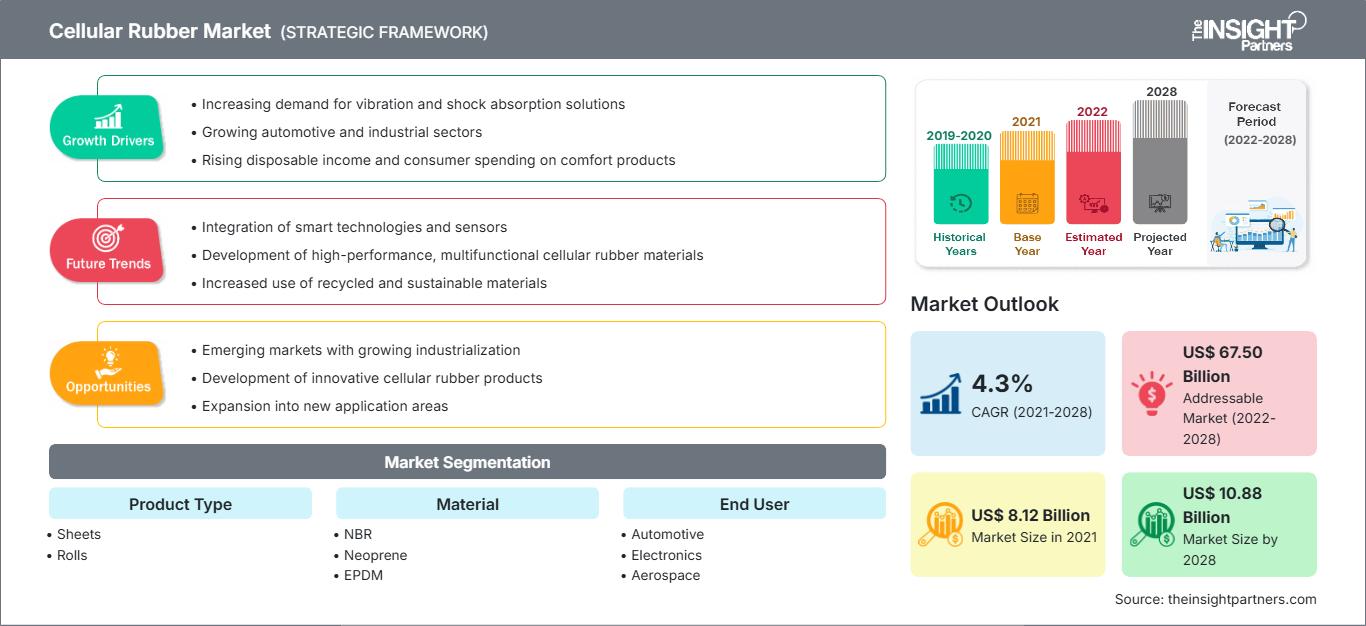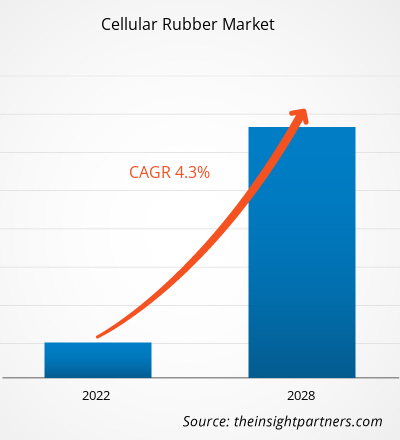Il mercato della gomma cellulare è stato valutato a 8.115,83 milioni di dollari nel 2021 e si prevede che raggiungerà i 10.884,41 milioni di dollari entro il 2028; si prevede una crescita a un CAGR del 4,3% dal 2021 al 2028.
La gomma cellulare è un tipo di gommapiuma con una struttura cellulare, in cui le celle non sono interconnesse. È leggera e comprimibile e il foglio di gomma è generalmente combinato con celle microporose per creare il foglio di gomma microcellulare. Questi fogli di gomma sono comunemente utilizzati per realizzare suole di scarpe e pantofole e sono progettati principalmente per garantire comfort, flessibilità e durata. La gomma cellulare è utilizzata nell'industria automobilistica per una varietà di applicazioni, tra cui la sigillatura di porte e camere d'aria e la produzione di pneumatici, oltre alla protezione di parti della carrozzeria dei veicoli dalle intemperie.
Si prevede che l'Europa deterrà la quota maggiore del mercato della gomma cellulare durante il periodo di previsione. Si prevede che il continuo progresso del settore automobilistico in questa regione alimenterà la crescita del mercato della gomma cellulare. La crescente domanda di automobili in tutta la regione è principalmente attribuita al crescente potere d'acquisto dei consumatori, al crescente numero di famiglie a doppio reddito, all'aumento della classe operaia e alla rapida crescita economica dei paesi. La gomma cellulare è sempre più utilizzata nel settore automobilistico grazie alle sue capacità di tenuta e riduzione del rumore. La gomma cellulare EPDM si lega rapidamente al metallo e funge da efficace scudo contro le intemperie; protegge inoltre i componenti dei veicoli dalle condizioni ambientali e del manto stradale e dalle vibrazioni.
L'interruzione della fornitura di materie prime come polietilene e polipropilene, che ha influenzato i processi produttivi, è stata un fattore primario che ha limitato la crescita del mercato della gomma cellulare durante la pandemia di COVID-19. Inoltre, l'aumento dei prezzi del petrolio greggio ha portato a fluttuazioni nei prezzi delle materie prime, creando ostacoli alla costante crescita del mercato. Tuttavia, il mercato della gomma cellulare ha registrato una domanda continua da parte di settori finali come l'automotive, l'edilizia, il riscaldamento, la ventilazione e l'aria condizionata (HVAC) e i beni di consumo. Inoltre, nell'ambito degli sforzi di ripresa economica, diversi settori stanno pianificando strategicamente di investire in materiali avanzati e di origine biologica, come la gomma cellulare, per rispondere alla crescente domanda di prodotti ecocompatibili. Il settore automobilistico ha iniziato a guadagnare slancio e si prevede che registrerà una crescita significativa nei prossimi anni con l'aumento delle vendite di veicoli elettrici, offrendo significative opportunità di crescita per gli operatori del mercato della gomma cellulare. Inoltre, la domanda di vari medicinali e vaccini contro il COVID-19 è aumentata notevolmente durante la pandemia di COVID-19 in tutto il mondo. Il commercio di queste entità sta aumentando la necessità di strutture e sistemi di stoccaggio adeguati, contribuendo alla domanda di gomma cellulare come sigillante e isolante.
Personalizza questo rapporto in base alle tue esigenze
Potrai personalizzare gratuitamente qualsiasi rapporto, comprese parti di questo rapporto, o analisi a livello di paese, pacchetto dati Excel, oltre a usufruire di grandi offerte e sconti per start-up e università
Mercato della gomma cellulare: Approfondimenti strategici

-
Ottieni le principali tendenze chiave del mercato di questo rapporto.Questo campione GRATUITO includerà l'analisi dei dati, che vanno dalle tendenze di mercato alle stime e alle previsioni.
Approfondimenti di mercato
Crescente domanda di gomma cellulare nel settore automobilistico
L'industria automobilistica è uno dei principali utilizzatori finali di gomma cellulare grazie alle sue proprietà benefiche, come la tenuta, la schermatura e l'elevata comprimibilità. Nel settore automobilistico, la gomma cellulare viene utilizzata principalmente nelle guarnizioni e nei giunti dei sistemi HVAC, nelle guarnizioni dei carburatori, nei cuscinetti antirumore, antivibrazioni e antiarmoniche, nelle guarnizioni dei cablaggi, nelle guarnizioni dei sistemi di illuminazione (interni ed esterni), nelle guarnizioni delle antenne e nelle guarnizioni del bagagliaio e delle portiere dei veicoli. Sebbene l'industria automobilistica sia da tempo un settore redditizio, è stata duramente colpita dalla pandemia di COVID-19. La crescente diffusione dei veicoli elettrici e l'imminente ripresa dell'industria automobilistica entro il 2022 dall'impatto della pandemia stanno stimolando la produzione automobilistica, che a sua volta sta trainando la domanda di gomma cellulare. L'Asia-Pacifico è un importante mercato automobilistico con la quota maggiore nella produzione di automobili, soprattutto in Cina, Giappone e India. Inoltre, si registra un'impennata della domanda di veicoli elettrici in tutto il mondo. Secondo i rapporti di EVAdoption, si prevede che la vendita di questi veicoli raggiungerà i 3.000.000 di unità entro il 2028, rispetto alle 507.710 unità del 2020 negli Stati Uniti.
Approfondimenti sulla tipologia di prodotto
In base alla tipologia di prodotto, il mercato globale della gomma cellulare è segmentato in lastre, rotoli e altri. Si prevede che il segmento delle lastre deterrà la quota maggiore del mercato durante il periodo di previsione. La gomma cellulare è un tipo di gommapiuma con una struttura cellulare, in cui le celle non sono interconnesse. È leggera e comprimibile e il foglio di gomma è generalmente combinato con celle microporose per creare il foglio di gomma microcellulare. Le lastre di gomma cellulare trovano applicazione in settori come l'automotive, l'aerospaziale e l'elettronica grazie alla facilità d'uso e alla capacità di conferire un isolamento efficace. Rappresentano inoltre una scelta ideale per scopi di sigillatura o protezione. Le lastre di gomma cellulare sono realizzate in diversi materiali, come NBR, neoprene ed EPDM, e sono disponibili in varie dimensioni e spessori. Le lastre di gomma cellulare EPDM sono ampiamente utilizzate come guarnizioni contro liquidi, finestre in alluminio e legno e telai di porte grazie alla loro eccellente resistenza all'invecchiamento, agli agenti atmosferici, all'ozono, all'ossigeno e ad altre sostanze chimiche.
Approfondimenti sui materiali
In base al materiale, il mercato globale della gomma cellulare è segmentato in gomma nitrile-butadiene (NBR), neoprene, gomma monomerica di etilene-propilene-diene (EPDM), silicone e altri. Si prevede che il segmento EPDM deterrà la quota maggiore del mercato durante il periodo di previsione. L'EPDM è una gomma sintetica ricavata dal petrolio greggio e viene sintetizzata tramite la polimerizzazione di tre monomeri. La gomma EPDM a celle chiuse è adatta per applicazioni ad alta pressione. È resistente all'umidità, ai raggi UV e all'ozono. Ciò rende il materiale EPDM un elastomero popolare per applicazioni come la sigillatura dei finestrini di veicoli e abitazioni.
Informazioni per l'utente finale
In base all'utente finale, il mercato globale della gomma cellulare è segmentato in automotive, elettronica, aerospaziale e altri settori. Si prevede che il segmento automotive deterrà la quota maggiore del mercato durante il periodo di previsione.
La gomma cellulare viene utilizzata per sigillare porte e camere d'aria e per la produzione di pneumatici per il settore automobilistico; protegge inoltre la carrozzeria dei veicoli da condizioni meteorologiche estreme. Viene inoltre utilizzata, tra le altre cose, per la produzione di componenti della carrozzeria e del telaio. La gomma cellulare EPDM è spesso utilizzata nell'industria automobilistica per le sue proprietà di tenuta e riduzione del rumore. I legami in EPDM presenti nella gomma cellulare si legano ai metalli per fornire una solida barriera contro gli agenti atmosferici e l'ambiente, la superficie stradale e le vibrazioni del motore. L'EPDM è inoltre resistente ai raggi UV e impermeabile. Pertanto, la versatilità della gomma cellulare EPDM ne consente l'utilizzo in diverse applicazioni automobilistiche.NDS-Seals, PANA Foamtec GmbH, ERIKS, Ridderflex, Polymax Ltd, Rogers Corporation, W. KöPP GmbH & Co. KG, SEDO Chemicals Neoprene GmbH, Kautschuk- und Kunststoffteile GmbH e Oskar Pahlke GmbH sono tra i protagonisti consolidati del mercato della gomma cellulare. Le aziende del settore stanno adottando strategie come lo sviluppo di prodotti, l'espansione degli impianti e fusioni e acquisizioni per espandere la propria presenza a livello mondiale e soddisfare la crescente domanda degli utenti finali.
Mercato della gomma cellulare
Le tendenze regionali e i fattori che influenzano il mercato della gomma cellulare durante il periodo di previsione sono stati ampiamente spiegati dagli analisti di The Insight Partners. Questa sezione illustra anche i segmenti e la geografia del mercato della gomma cellulare in Nord America, Europa, Asia-Pacifico, Medio Oriente e Africa, America meridionale e centrale.
Ambito del rapporto sul mercato della gomma cellulare
Densità degli operatori del mercato della gomma cellulare: comprendere il suo impatto sulle dinamiche aziendali
Il mercato della gomma cellulare è in rapida crescita, trainato dalla crescente domanda degli utenti finali, dovuta a fattori quali l'evoluzione delle preferenze dei consumatori, i progressi tecnologici e una maggiore consapevolezza dei vantaggi del prodotto. Con l'aumento della domanda, le aziende stanno ampliando la propria offerta, innovando per soddisfare le esigenze dei consumatori e sfruttando le tendenze emergenti, alimentando ulteriormente la crescita del mercato.

- Ottieni il Mercato della gomma cellulare Panoramica dei principali attori chiave
In evidenza nel rapporto
- Tendenze progressive del settore nel mercato della gomma cellulare per aiutare gli operatori a sviluppare strategie efficaci a lungo termine
- Strategie di crescita aziendale adottate dai mercati sviluppati e in via di sviluppo
- Analisi quantitativa del mercato della gomma cellulare per il periodo 2019-2028
- Stima della domanda di gomma cellulare in vari settori
- Sviluppi recenti per comprendere lo scenario competitivo del mercato e la domanda di gomma cellulare
- Tendenze e prospettive di mercato insieme ai fattori che regolano la crescita del mercato della gomma cellulare
- Comprensione delle strategie che sostengono l'interesse commerciale per quanto riguarda la crescita del mercato globale della gomma cellulare
- Panoramica dettagliata e segmentazione del mercato globale della gomma cellulare nonché le sue dinamiche nel settore
- Dimensioni del mercato della gomma cellulare in varie regioni con promettenti opportunità di crescita
Il rapporto mira a fornire un Panoramica del mercato con segmentazione dettagliata in base a tipologia di prodotto, materiale, utilizzo finale e area geografica. In base alla tipologia di prodotto, il mercato della gomma cellulare è segmentato in lastre, rotoli e altri materiali. In base al materiale, il mercato della gomma cellulare è segmentato in NBR, neoprene, EPDM, silicone e altri. In base all'utente finale, il mercato è segmentato in automotive, elettronica, aerospaziale e altri. In base all'area geografica, il mercato della gomma cellulare è segmentato in cinque regioni principali: Nord America, Europa, Asia Pacifico, Medio Oriente e Africa, Sud e Centro America.
Profili aziendali
- NDS-SEALS
- Pana Foamtec GmbH
- Eriks
- Ridderflex
- Polymax Ltd
- Rogers Corporation
- W. KÖPP GmbH & Co. KG
- SEDO Chemicals Neoprene GmbH
- Kautschuk- und Kunststoffteile GmbH.
- Oskar Pahlke GmbH
- Analisi storica (2 anni), anno base, previsione (7 anni) con CAGR
- Analisi PEST e SWOT
- Valore/volume delle dimensioni del mercato - Globale, Regionale, Nazionale
- Industria e panorama competitivo
- Set di dati Excel
Report recenti
Rapporti correlati
Testimonianze
Motivo dell'acquisto
- Processo decisionale informato
- Comprensione delle dinamiche di mercato
- Analisi competitiva
- Analisi dei clienti
- Previsioni di mercato
- Mitigazione del rischio
- Pianificazione strategica
- Giustificazione degli investimenti
- Identificazione dei mercati emergenti
- Miglioramento delle strategie di marketing
- Aumento dell'efficienza operativa
- Allineamento alle tendenze normative






















 Ottieni un campione gratuito per - Mercato della gomma cellulare
Ottieni un campione gratuito per - Mercato della gomma cellulare